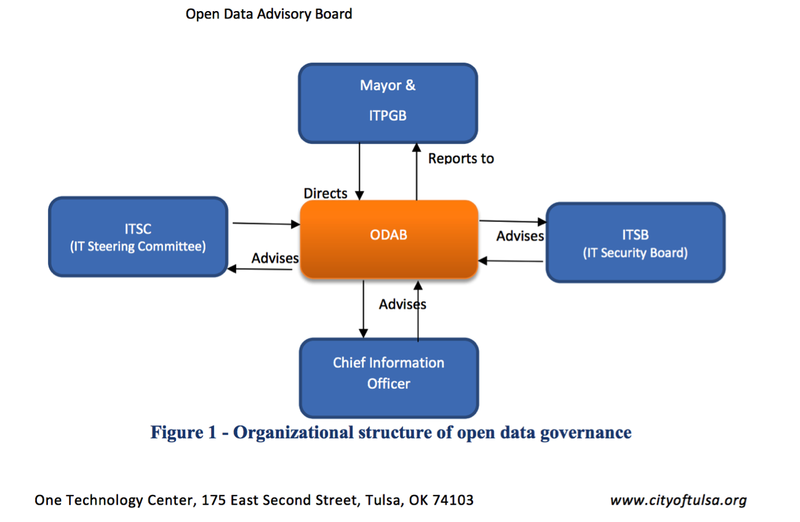Tulsa brings a new kind of energy to its open data policy and practice

The Sunlight Foundation and our partners at the Center for Government Excellence at Johns Hopkins University (GovEx) continue to accelerate the municipal open data movement through our participation in the What Works Cities initiative. Sunlight has supported local governments in the development of meaningful and sustainable open data policies, and since the launch of the What Works Cities program in August, six cities committed to the use of data and evidence have adopted new open data policies, now including Tulsa, Okla., where City Manager Jim Twombly, acting on behalf of Mayor Dewey Bartlett, Jr., signed Executive Order 2015-07 “Providing for an Open Data Program to Provide Public Availability, Accessibility, and Government Transparency; and Creating an Open Data Advisory Board.”
The executive order and the accompanying Open Data Advisory Board Charter are now available on the Open Tulsa website.
Tulsa’s new open data policy framework not only advances a number of best practices from Sunlight’s open data policy guidelines, but importantly builds upon the foundation of a 2013 “Open and Accessible Data” resolution to create a previously absent structure needed to drive the implementation of a renewed open data effort.
Renewing the open data vows
While Tulsa’s existing City Council Resolution — developed during 2012-2013 with feedback from Code for Tulsa — had set a number of lofty goals, that policy was short on the kinds of actionable details that are often crucial to an open data program’s success, such as clarifying who would be responsible for identifying and sharing open data and what steps that process would entail.
By contrast, in building upon the aspirations of the city’s original resolution, the new policy push is squarely focused in on the who and the what of implementation. It formally designates the city’s previously established Open Tulsa website as the “authoritative source for Open Data provided by the City,” and wastes no time in creating an Open Data Advisory Board (ODAB), made up of data coordinators from each department as well as nonvoting community members (including members of Code for Tulsa). This official oversight body is also tasked with formally creating the city’s open data program and developing a concrete implementation plan.
Chart(er)ing a new path forward
Perhaps what makes this renewal of Tulsa’s open data vows most significant though, is the previously mentioned Open Data Advisory Board Charter called for in the executive order and signed by City Manager Twombly and CIO Michael Dellinger. The charter serves to integrate the city’s open data objectives (and a community perspective) into the very structure of the city’s IT governance. Although an ad hoc working group had met previously to advocate for open data, the now chartered ODAB finally fulfills the (perhaps half-hearted) promise of Tulsa’s 2013 resolution to “establish a committee of city employees and local volunteers to aid in the achievement of [open data] goals.”
As Code for Tulsa co-captain and Open Data Advisory Board member Carlos Moreno puts it in a recent blog post on Tulsa’s progress: “This new Advisory Board will serve to educate and collaborate with even more departments within City Hall, as well as work to re-design the Open Data Portal — a repository of all the public datasets published by the City.” Moreno is also enthused by the prospect of community leaders like himself being more involved in multiple aspects of the open data process, saying in an email, “It’s been exciting to have a seat at the table inside of city hall, working hard not just on civic tech projects, but also the governance and policy around open data.”
The charter not only defines the ODAB’s implementation-focused mission and responsibilities, but also spells out the concrete deliverables to be produced (a citywide open data plan, a data classification policy, a citywide open data policy and technical standards manual, and an annual open data report) and in some instances even sets timelines for completion (we weren’t joking about that new focus on action steps!). Finally, because the ODAB is an officially chartered component of the city of Tulsa’s IT governance, it will have an advisory say on a matter many open data programs overlook: allocation of resources.

More work to be done
While Tulsa’s new open data policy isn’t perfect (see: the entire section devoted to “Reservations”), it represents a significant step forward for a mid-sized city looking to expand its current practice in transparency, accountability and community engagement through the proactive release of public information online.
As Tulsa’s Penny Marcias told Sunlight’s readers last October, Tulsa faces real challenges but is committed to making progress. Its current data portal contains just 35 datasets and receives little traffic or public input, and even with the recent executive order and ODAB charter, there are certainly important policy questions left unaddressed (e.g. the need to spell out an explicit process for review of sensitive information). Though some of these important aspects are yet to be determined, we eagerly anticipate the production of the more detailed open data implementation plan and associated forthcoming documents and hope to see these aspects addressed there.
To be sure, Tulsa has much work ahead. But with Tulsa’s new policy framework, the city has successfully focused on implementation and put in place a strategy for getting there with a new kind of energy.

